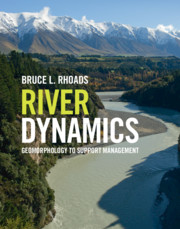Book contents
- River Dynamics
- Reviews
- River Dynamics
- Copyright page
- Contents
- Preface
- Chapter 1 Introduction
- Chapter 2 The Dynamics of Drainage Basins and Stream Networks
- Chapter 3 Sediment Dynamics at Global and Drainage-Basin Scales
- Chapter 4 Flow Dynamics in Rivers
- Chapter 5 Sediment Transport Dynamics in Rivers
- Chapter 6 Magnitude-Frequency Concepts and the Dynamics of Channel-Forming Events
- Chapter 7 The Shaping of Channel Geometry
- Chapter 8 Channel Planform – Controls on Development and Change
- Chapter 9 The Dynamics of Meandering Rivers
- Chapter 10 The Dynamics of Braided Rivers
- Chapter 11 The Dynamics of Anabranching Rivers
- Chapter 12 The Dynamics of River Confluences
- Chapter 13 The Vertical Dimension of Rivers: Longitudinal Profiles, Profile Adjustments, and Step-Pool Morphology
- Chapter 14 The Dynamics of Floodplains
- Chapter 15 Human Impacts on River Dynamics
- Chapter 16 River Dynamics and Management
- Book part
- Symbols
- References
- Index
- Plate Section (PDF Only)
Chapter 1 - Introduction
Published online by Cambridge University Press: 30 April 2020
- River Dynamics
- Reviews
- River Dynamics
- Copyright page
- Contents
- Preface
- Chapter 1 Introduction
- Chapter 2 The Dynamics of Drainage Basins and Stream Networks
- Chapter 3 Sediment Dynamics at Global and Drainage-Basin Scales
- Chapter 4 Flow Dynamics in Rivers
- Chapter 5 Sediment Transport Dynamics in Rivers
- Chapter 6 Magnitude-Frequency Concepts and the Dynamics of Channel-Forming Events
- Chapter 7 The Shaping of Channel Geometry
- Chapter 8 Channel Planform – Controls on Development and Change
- Chapter 9 The Dynamics of Meandering Rivers
- Chapter 10 The Dynamics of Braided Rivers
- Chapter 11 The Dynamics of Anabranching Rivers
- Chapter 12 The Dynamics of River Confluences
- Chapter 13 The Vertical Dimension of Rivers: Longitudinal Profiles, Profile Adjustments, and Step-Pool Morphology
- Chapter 14 The Dynamics of Floodplains
- Chapter 15 Human Impacts on River Dynamics
- Chapter 16 River Dynamics and Management
- Book part
- Symbols
- References
- Index
- Plate Section (PDF Only)
Summary
This introductory chapter discusses what a river is; why rivers are important, both as natural features that shape the Earth’s surface and as resources for society; the science of fluvial geomorphology, including a brief history of this field; the process-oriented perspective of the book; rivers as dynamic natural systems; general concepts, such as dynamic equilibrium, thresholds, and nonlinear system dynamics, that have been employed to describe the dynamics of river systems; and the importance of both physical processes and environmental/historical contingency as factors influencing the dynamics of river systems. It presents a conceptual model defining rivers as dynamic systems characterized by interaction among flow, sediment transport, and channel form. It defines a hierarchy of spatial and temporal scales relevant to the characterization of river systems.
- Type
- Chapter
- Information
- River DynamicsGeomorphology to Support Management, pp. 1 - 14Publisher: Cambridge University PressPrint publication year: 2020

